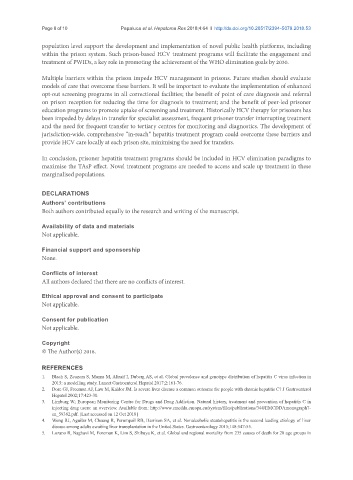Page 718 - Read Online
P. 718
Page 8 of 10 Papaluca et al. Hepatoma Res 2018;4:64 I http://dx.doi.org/10.20517/2394-5079.2018.53
population level support the development and implementation of novel public health platforms, including
within the prison system. Such prison-based HCV treatment programs will facilitate the engagement and
treatment of PWIDs, a key role in promoting the achievement of the WHO elimination goals by 2030.
Multiple barriers within the prison impede HCV management in prisons. Future studies should evaluate
models of care that overcome these barriers. It will be important to evaluate the implementation of enhanced
opt-out screening programs in all correctional facilities; the benefit of point of care diagnosis and referral
on prison reception for reducing the time for diagnosis to treatment; and the benefit of peer-led prisoner
education programs to promote uptake of screening and treatment. Historically HCV therapy for prisoners has
been impeded by delays in transfer for specialist assessment, frequent prisoner transfer interrupting treatment
and the need for frequent transfer to tertiary centres for monitoring and diagnostics. The development of
jurisdiction-wide, comprehensive “in-reach” hepatitis treatment program could overcome these barriers and
provide HCV care locally at each prison site, minimising the need for transfers.
In conclusion, prisoner hepatitis treatment programs should be included in HCV elimination paradigms to
maximise the TAsP effect. Novel treatment programs are needed to access and scale up treatment in these
marginalised populations.
DECLARATIONS
Authors’ contributions
Both authors contributed equally to the research and writing of the manuscript.
Availability of data and materials
Not applicable.
Financial support and sponsorship
None.
Conflicts of interest
All authors declared that there are no conflicts of interest.
Ethical approval and consent to participate
Not applicable.
Consent for publication
Not applicable.
Copyright
© The Author(s) 2018.
REFERENCES
1. Blach S, Zeuzem S, Manns M, Altraif I, Duberg AS, et al. Global prevalence and genotype distribution of hepatitis C virus infection in
2015: a modelling study. Lancet Gastroenterol Hepatol 2017;2:161-76.
2. Dore GJ, Freeman AJ, Law M, Kaldor JM. Is severe liver disease a common outcome for people with chronic hepatitis C? J Gastroenterol
Hepatol 2002;17:423-30.
3. Limburg W; European Monitoring Centre for Drugs and Drug Addiction. Natural history, treatment and prevention of hepatitis C in
injecting drug users: an overview. Available from: http://www.emcdda.europa.eu/system/files/publications/344/EMCDDAmonograph7-
en_59382.pdf. [Last accessed on 12 Oct 2018]
4. Wong RJ, Aguilar M, Cheung R, Perumpail RB, Harrison SA, et al. Nonalcoholic steatohepatitis is the second leading etiology of liver
disease among adults awaiting liver transplantation in the United States. Gastroenterology 2015;148:547-55.
5. Lozano R, Naghavi M, Foreman K, Lim S, Shibuya K, et al. Global and regional mortality from 235 causes of death for 20 age groups in

